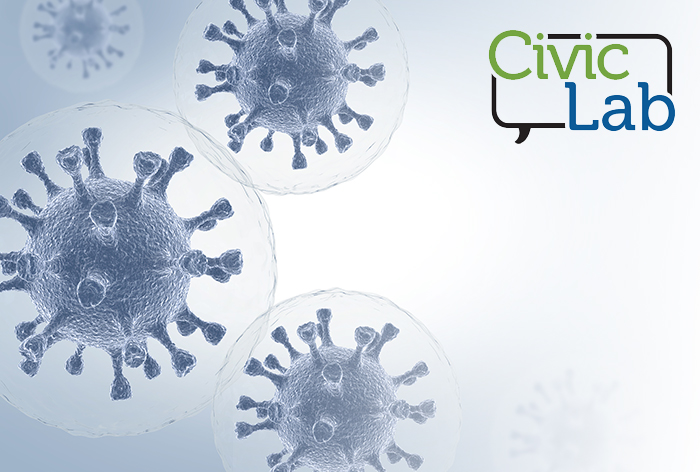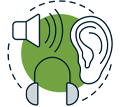Civic Lab Online: What we know about the COVID-19 Pandemic
Posted on November 10, 2020 at 6:00 am

ABOUT CIVIC LAB ONLINE
Civic Lab Online provides information on issues facing our community for you to explore. Take a look at thought-provoking materials for teens and adults that allow us to engage in open conversation and grow together as a community. You’ll find all past topics on the Civic Lab Online web page.
WHAT WE KNOW ABOUT THE COVID-19 PANDEMIC
There are many things we don’t yet know about the novel coronavirus (COVID-19), the disease that has caused a worldwide pandemic. Scientists, researchers, and medical professionals continue to look for answers about how the virus will behave seasonally, how to create a working vaccine, and how long the virus remains intact in certain environments. Here we provide facts on what we do know about the virus so far, including how it spread across the world and what the science is behind keeping ourselves safe.
Fast Facts

Where did coronavirus come from? How long have we known about it?
Coronaviruses are a widespread and a common kind of illness, responsible for a large percentage of the world’s common colds. They are classified together because of how they look under a microscope rather than by their symptoms.
Coronaviruses are zoonotic, meaning they come from animals. Alpha and beta coronaviruses can jump from animals to people (delta and gamma coronaviruses cannot) and are usually mild except for SARS, MERS, and COVID-19. The three more serious coronaviruses can infect your lower respiratory tract (more of the lungs) and, therefore, are much more serious. All three originate from bats, but that doesn’t mean people are eating bats or being bitten by them—the viruses may spread to several other animals before developing the means to infect humans.
COVID-19 is an acronym for COrona VIrus Disease and 2019 when it was discovered. It is also called SARS-CoV-2, and it is closely related to SARS, which was contained as an epidemic in 2003.
The first cases of COVID-19 were identified in December 2019 in the Huanan seafood market in Wuhan, China, likely from animal to person spread. Person to person spread was quickly evident. COVID-19 has since had reports of community spread, meaning that people have tested positive with no known connection to a person or object with the virus.
Indications have been present for some time that a new epidemic may be caused by a virus moving from animals to humans. In 2009, the U.S. created a program to do the complicated and expensive work of watching for dangerous viruses, called PREDICT. In September 2019, funding was cut. Very few equivalent programs are being funded worldwide, making it difficult to shut down markets near large numbers of infected animals or high-risk meat markets.
How many cases are in particular areas? Locally?
Broadstreet’s interactive map (best viewed in Chrome) is updated daily to show the number of people who have tested positive for novel coronavirus according to county, state, and nation. It also shows how many people have died from the virus in each area.
Spokane Regional Health District is releasing daily information for Spokane on the number of infected and hospitalized, both total numbers and new for the day.
What exactly is Novel Coronavirus? How do I kill it?
Novel coronavirus (COVID-19) is a virus made of genetic material surrounded by oily lipid fats. The spiky proteins that stick out of it help it enter healthy cells. These spiky proteins inspired the name “corona” because of their crown-like look (“corona” is Spanish for “crown”).
According to Scientific American, viruses exist in a hard to define grey area between living and nonliving things: they cannot replicate by themselves, and they can only do so in cells that are alive. They cannot move themselves, and they aren’t born or killed according to conventional definitions. Viruses often have a strong effect on the behaviour or health of their host and are a major part of the cycle of life. When talking about “killing a virus,” we could be talking about breaking it up on a surface before it infects someone, or we could be talking about someone’s immune system fighting the virus.
When novel coronavirus is outside of your body, the best way to destroy it is to clean it. Soap at a molecular level has a head that bonds to water and a tail that avoids it (in favor of fats). Soap acts as a crowbar, prying open the oily coating of COVID-19 and breaking it up. The pieces float away in bubbles called micelles, washed away by water. Hand sanitizer works similarly, but does not wash away the broken up microorganisms from your skin or any microbes that got missed. Your best weapon is working up a lather with soap.
There have not yet been any scientific studies on which disinfectant cleaners work best against novel coronavirus, but researchers do have lists based on what destroys other coronaviruses. The Center for Disease Control (CDC) has released recommendations on how much of each disinfectant to use and for how long. The most important thing to remember is to leave disinfectant on surfaces long enough to do its job, rather than wiping it off immediately.
There is currently no recommended medicine for novel coronavirus once you are infected with it, but you can try to soothe your symptoms using a fever reducer, cough medicine, and a humidifier. Antibiotics cannot treat COVID-19 because it is a virus and not a bacteria. Antiviral drugs or a vaccine may be developed in the future. Other treatments and antiviral medicines are currently being tested.
The CDC recently issued an update on the development of a vaccine. Five federal regions (four states and a city) have been chosen to be pilot states in the CDC’s plan. Washington state is not one of those in the CDC’s plan, but Washington state plans to base its plan on the findings of those areas. If a safe, effective vaccine is developed, priority will be given to essential workers, health care workers, and residents and workers at long-term care facilities. Out of the 170 COVID-19 vaccines in development, only 9 have advanced into the final phase of FDA trials, known as Phase 3. These large scale trials test if the vaccine is safe for the public. Vaccines usually take years to develop, but priority has been given to finding a COVID-19 vaccine much sooner than is typical.
Read. Watch. Listen.

Read
“CDC: Coronavirus Disease 2019 (COVID-19).” Centers for Disease Control and Prevention (CDC). Accessed 28 August 2020. https://www.cdc.gov/coronavirus/2019-ncov/index.html
The CDC has answered the most commonly asked questions about COVID-19, breaking down need-to-know information into categories, including “if you are sick” and the newest information on face masks.
Lerner, K. Lee, and Brenda Wilmoth Lerner. “Novel coronavirus outbreak (Covid-19).” Gale Science Online Collection, Gale, 2020. Gale in Context: Science. Accessed 28 August 2020.
https://www.scld.org/digital_downloads/science-in-context/.
This is a history of COVID-19 from its discovery to the current restrictions on travel and large groups. The article also includes a list of key terms to know and what epidemiologists have discovered so far.

Watch
Pandemic: How to Prevent an Outbreak. Netflix Original Series, 22 January 2020.
This Netflix docuseries profiles the men and women on the front lines of the battle against influenza. Their predictions about what the next global outbreak would look like were made just months before the discovery of COVID-19. Pandemic covers the controversies around vaccination laws, the process of quarantining and transporting someone with a highly contagious disease, and how disease makes the shift from animals to people.
“Answers to Questions about COVID-19 and Unemployment Benefits.” Unemployment Law Project. Accessed 28 August 2020. http://unemploymentlawproject.org/event/webinar-more-answers-to-questions-about-covid-19-and-unemployment-benefits/?mc_cid=540fb9ca16&mc_eid=5632e53ea3
This recurring Zoom webinar (Mondays at 12:00 PM PDT) will answer common questions on how to navigate unemployment during COVID-19 if your place of employment was not deemed an essential service or if you have lost your job since the start of the pandemic. Members of the public will have the opportunity to pose their own questions to a representative after the presentation.

Listen
”Coronavirus disease (COVID-2019) press briefings.” World Health Organization. Accessed 28 August 2020. https://www.who.int/emergencies/diseases/novel-coronavirus-2019/media-resources/press-briefings
The World Health Organization provides both video and audio files of ongoing press briefings regarding what is happening worldwide with the Novel Coronavirus.
Digital Resources
Science in Context
Access COVID-19 information on Science in Context.
Print & Other Materials in Our Catalog
Search our catalog for books, including large print, eBooks, and audiobooks about COVID-19.
Additional Information
Is it true that I can zap the novel coronavirus (COVID-19) with an ultraviolet (UV) light?
Specific UV light beams can warp viruses and keep them from replicating in living cells. However, it won’t do you much good at home. There are three types of UV wavelengths in the spectrum of light according to the manufacturers at UV Light Technology. Only ultraviolet C (UVC) light breaks apart viruses. It’s very good at destroying all genetic material—including you (UVC is what the ozone layer and sunscreen protects us from). A concentrated UVC light isn’t the type of UV light you might have around the house. It is being used experimentally on subways, buses, and money in banks (when people are not present) to fight COVID-19, and there’s no reason to rush to your local hardware store for a UV light. If you do have one, be sure to keep the light away from your skin and eyes.
Has my time in the summer sun prevented me from getting COVID-19?
A recent university study has found that, while higher heat and humidity can slow the spread of COVID-19, longer hours of sunlight are actually associated with a higher incidence of the disease. This could be a sign that sunny days can tempt more people outdoors, even if this means a higher risk of infection. There is no evidence, however, that if you show early symptoms time in the sun will improve your symptoms or make you less infected.
Is it true that sweat and other droplets can spread from a person jogging or cycling and infect me?
There is not yet any evidence that will happen. A team of researchers from Belgium did create a simulation to show the droplets from coughs, sneezes, sweat, and other exhalations from people biking or exercising and how they move in the air. However, when they spoke to the media about their project prior to the study being complete and the findings were peer reviewed, rumors of a study saying outdoor exercise is unsafe went viral.
At this point, there is no concrete evidence that you are likely to be infected by running outdoors or biking. Continuing to observe social distancing while doing anything in a public place is a good idea.
You do not need to wear a mask while jogging or doing other outdoor exercise according to the World Health Organization’s list of common myths.
Downloadable Documents
- Fast Facts: COVID-19 Pandemic
- Read, Watch, Listen: COVID-19 Pandemic
- Additional Information: COVID-19 Pandemic
Tags: adults, civic lab, civil discourse, civility, community, coronavirus, COVID-19, Discussion, issues, social discourse, teens

